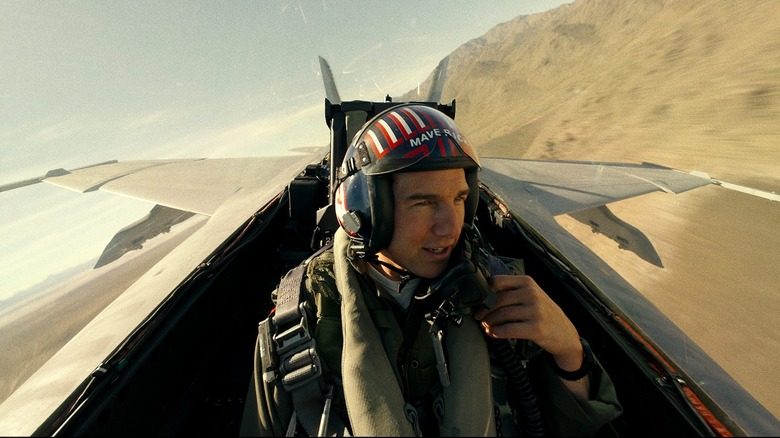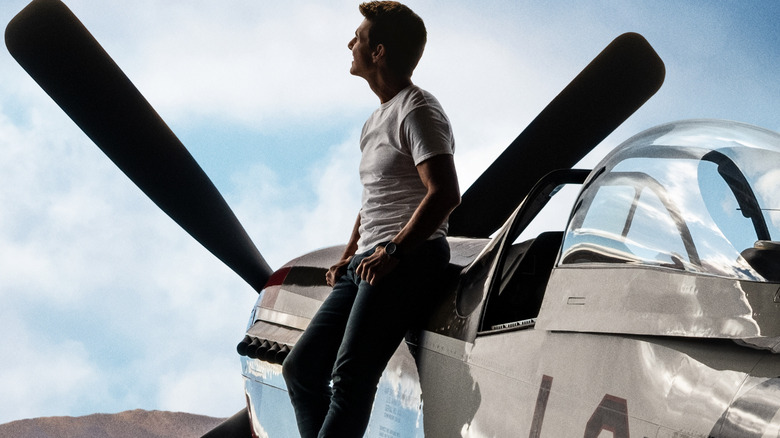Top Gun: Maverick Had To Toe The Line When It Came To Casting Its Villains
For better or worse, the landscape that "Top Gun: Maverick" is debuting in during the year 2022 is far different from the one that the Tony Scott classic experienced upon release in 1986. Looking back, it's mildly startling to realize that the climax of the original film revolved around the United States Navy's most elite squadron of pilots directly engaging Soviet MiG fighter jets in aerial combat. Aircraft are shot down, people die ... and, somehow, this conflict doesn't escalate into a full-blown disaster at the height of nuclear tensions between the two superpowers.
Of course, that's mostly because the film had its focus firmly set elsewhere, rather than abiding by the strict real-world politics of the decade (beyond using Russians as the main antagonist, naturally). "Top Gun" is a hyper-macho, jingoistic, and breezy thrill ride that's utterly unconcerned about some of the darker elements of its premise, which likely helps explain why it has endured for as long as it has. Its legacy sequel, however, needed to take far more nuanced considerations into mind.
Despite current real-world conflicts echoing many of the same imperialistic mindsets that fueled the Cold War, the creative team behind "Top Gun: Maverick" ultimately took a drastically different approach when deciding on who the villains of the sequel should be. With the global box office now more important than ever to the success of Hollywood productions, capitalism has (ironically) begun to curtail some of the worst depictions of foreign stereotypes in major blockbusters. So where did that leave "Top Gun: Maverick" in terms of providing a credible threat to boost the stakes of the film?
The solution involved some deft maneuvering of its own.
Threading the needle
Even the staunchest fans of the original "Top Gun" would largely consider the film to be a product of its time, particularly where those endless "Danger Zone" needle drops are concerned. But while the story largely focuses on the camaraderie between Maverick (Cruise) and his best bud Goose (Anthony Edwards), Maverick's daddy issues, and the love story between himself and Charlie (Kelly McGillis), the choice of villain in both the opening and closing sequences similarly reminds viewers of precisely when "Top Gun" is meant to take place.
So when director Joseph Kosinski, credited writers Peter Craig, Justin Marks, Ehren Kruger, Eric Warren Singer, and Christopher McQuarrie, and prolific producer Jerry Bruckheimer all faced the task of creating a sequel set decades later, this posed a few challenges regarding the villains. In a profile with the U.K.-based newspaper The Times, Bruckheimer opened up about the realities of making a "Top Gun" movie in the 21st century by essentially opting for faceless, nationless villains. Ruefully admitting that they attempted something similar by only ever referring to enemy jets as "bogies" or "MiGs" in the original ("Well, it was meant to be vague," he laughed, "but we didn't do a good job"), Bruckheimer said:
"You don't want to shut off market. When you make an expensive movie you want to give the studio the best opportunity to make money. It has got harder. You have to figure out a way to create a villain who is multinational or doesn't have a home."
All indications point towards the high-flying blockbuster succeeding in spite of such generalities. No movie is made in a vacuum, but perhaps "Top Gun: Maverick" proves the truth of this saying even more than most.

